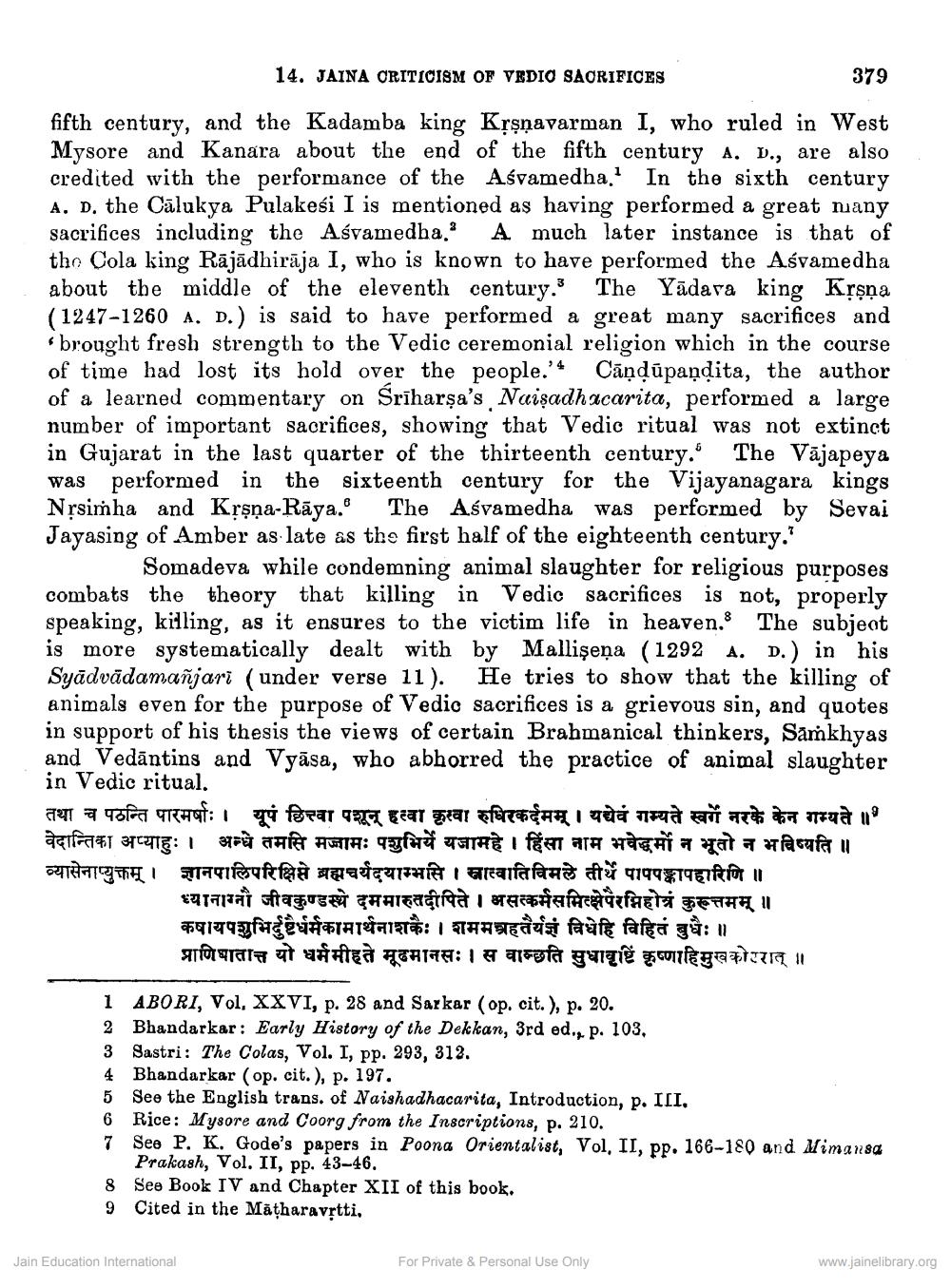________________
14. JAINA CRITICISM OF VEDIO SACRIFICES
379
fifth century, and the Kadamba king Kṛṣṇavarman I, who ruled in West Mysore and Kanara about the end of the fifth century A. D., are also credited with the performance of the Aśvamedha. In the sixth century A. D. the Calukya Pulakesi I is mentioned as having performed a great many sacrifices including the Aśvamedha," A much later instance is that of the Cola king Rājādhirāja I, who is known to have performed the Asvamedha about the middle of the eleventh century.3 The Yadava king Kṛṣṇa (1247-1260 A. D.) is said to have performed a great many sacrifices and brought fresh strength to the Vedic ceremonial religion which in the course of time had lost its hold over the people.'* Candupandita, the author of a learned commentary on Śrīharṣa's Naisadhacarita, performed a large number of important sacrifices, showing that Vedic ritual was not extinct in Gujarat in the last quarter of the thirteenth century." The Vajapeya was performed in the sixteenth century for the Vijayanagara kings Nrsimha and Kṛṣṇa-Raya. The Asvamedha was performed by Sevai Jayasing of Amber as late as the first half of the eighteenth century.'
Somadeva while condemning animal slaughter for religious purposes combats the theory that killing in Vedic sacrifices is not, properly speaking, killing, as it ensures to the victim life in heaven. The subject is more systematically dealt with by Mallişena (1292 A. D.) in his Syādvādamañjari (under verse 11). He tries to show that the killing of animals even for the purpose of Vedic sacrifices is a grievous sin, and quotes in support of his thesis the views of certain Brahmanical thinkers, Samkhyas and Vedantins and Vyasa, who abhorred the practice of animal slaughter in Vedic ritual.
तथा च पठन्ति पारमर्षाः । यूपं हित्वा पशून् हत्वा कृत्वा रुधिरकर्दमम् । यद्येवं गम्यते स्वर्गे नरके केन गम्यते ॥ वेदान्तिका अप्याहुः । अन्धे तमसि मज्जामः पशुभिर्ये यजामहे । हिंसा नाम भवेद्धर्मो न भूतो न भविष्यति ॥ व्यासेनाप्युक्तम् । ज्ञानपालिपरिक्षिप्ते ब्रह्मचर्यदयाम्भसि । स्नात्वातिविमले तीर्थे पापपङ्कापहारिणि ॥ ध्यानाग्नौ जीवकुण्डस्थे दममारुतदीपिते । असत्कर्म समित्क्षेपैरग्निहोत्रं कुरूत्तमम् ॥ कषायपशुभिर्दुष्टैर्धर्मकामार्थनाशकैः । शममन्त्रहतैर्यज्ञं विधेहि विहितं बुधैः ॥
प्राणिघातात यो धर्ममीहते मूढमानसः । स वान्छति सुधावृष्टिं कृष्णा हि मुखकोररात् ॥
1 ABORI, Vol. XXVI, p. 28 and Sarkar (op. cit.), p. 20. Bhandarkar: Early History of the Dekkan, 3rd ed., p. 103,
2
Sastri: The Colas, Vol. I, pp. 293, 312.
Bhandarkar (op. cit.), p. 197.
See the English trans. of Naishadhacarita, Introduction, p. III.
3
4
5
6
7
Rice: Mysore and Coorg from the Inscriptions, p. 210.
See P. K. Gode's papers in Poona Orientalist, Vol. II, pp. 166-180 and Mimansa Prakash, Vol. II, pp. 43-46.
8
See Book IV and Chapter XII of this book.
9 Cited in the Matharavṛtti,
Jain Education International
For Private & Personal Use Only
www.jainelibrary.org




